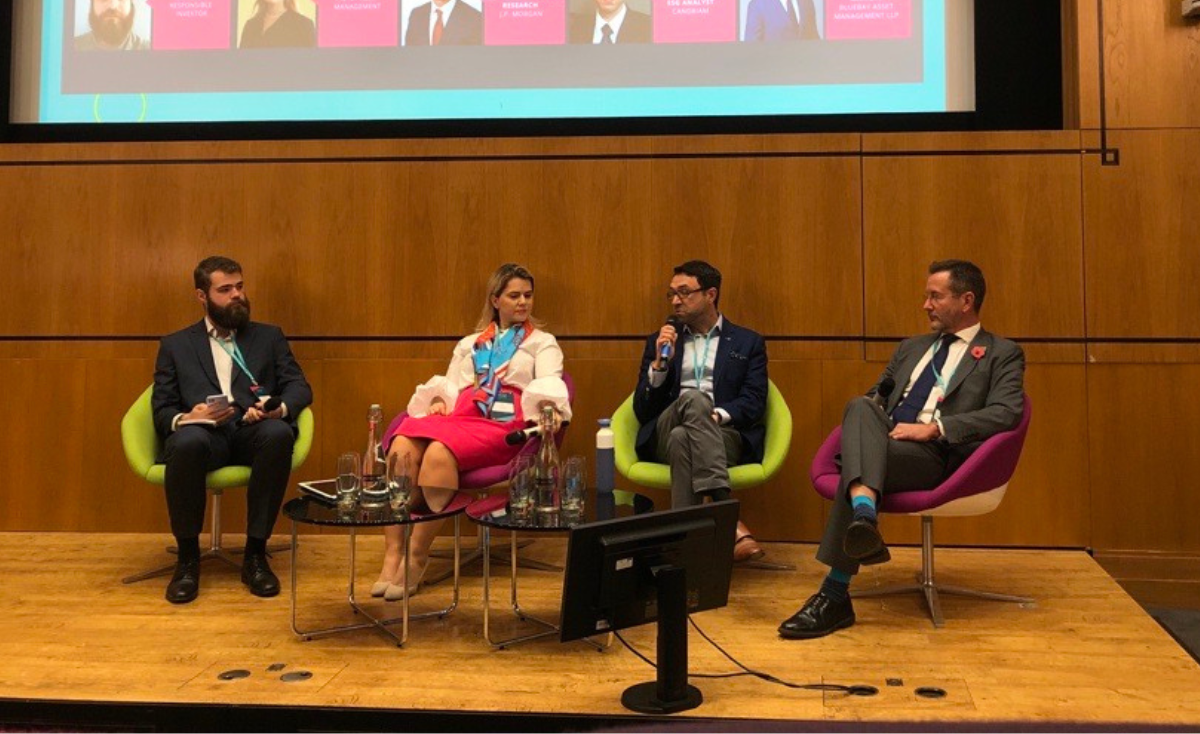
Several industry leaders say engagement is tricky but necessary when it comes to sovereign debt ESG investing.
At the UK Sustainable Investment and Finance Association’s (UKSIF) Autumn Conference in London this week, a panel discussion on hurdles in sovereign debt ESG investing found that there was still a lot of work to do in this sphere, and a consensus is a long way off.
The panel – which included Ella Hoxha, Senior Investment Management, Pictet Asset Management, Kroum Sourov, Lead Sovereign ESG Analyst, Candriam, and Graham Stock, Partner, Senior Sovereign Strategist, Emerging Markets, Bluebay Asset Management – said that sustainability-linked bonds (SLBs) were more attractive than green bonds when it came to future scope for investors, but there were still downsides.
Because the sovereign debt market has historically been the largest asset class, it is seen as critical to driving economic change, said the panel. “It’s the deepest, most liquid, and most impactful asset class,” Hoxha said. She added that, as recently seen in Europe, bond markets can be powerful when it comes to encouraging change, but that green bonds shouldn’t be the starting point, as important as they are.
" We need to look at different factors across E, S, and G areas
and link them back to materiality."
This was especially so when ESG data is boiled down to a singular metric. "There’s a problem with reducing ESG to one data point,” Stock said. His comments align with much of the industry consensus now, which is quick to point out that there are issues when ESG is seen as a catchall term with uniform applications. “We need to look at different factors across E, S, and G areas, and link them back to materiality for fixed income portfolios,” said Stock.
This is because ESG operates differently across various economies, whether emerging or developed. Contextual information is key in determining whether investment choices make sense or not. If we rely too much on homogenous definitions and simplistic data, Stock said, there could be hazardous results. “We risk cutting off capital flows to the countries who need them most.” Investors should be wary about how they use data – not only about where it comes from.
"The level of dialogue around ESG issues should be the same as inflation.”
Sourov said that the lack of correlation between ratings – due to different philosophies and frameworks – and the varied stances on the divestment versus engagement debate add fuel to the fire. “The investment community is integral, and we need simple messaging for complex problems to reach civic society,” he said. “Five years down the road, the level of dialogue around ESG issues such as deforestation should be the same as inflation.”
This goal, though, is made difficult by the lack of commonality in ESG reporting. When Sourov spoke to Insurance Investor in June this year, he said that having a clear understanding of the rating provider’s methodology – if using third-party data – is paramount. “Relying on third-party assessment is a double-edged sword,” he added. If investors are to rely on ESG metrics, which increasingly they do, they will need to better understand how ratings and reports are generated.
Discussing whether sustainability-linked bonds (SLBs) are more appropriate debt instruments than green bonds for sovereign issuers, Stock said that how governments reach their targets is up to them. However, there is more scope for the expansion of SLBs. “Green bonds are, by definition, limited,” he added. “Governments should let the private sector invest in green bonds.”
"Green bonds are, by definition, limited. Governments should let
the private sector invest in green bonds.”
The SLB market is growing quickly. A Linklaters report from June said that the global sustainable bond market raised $442 billion in the first six months of this year with sustainability-linked bonds seeing the most pronounced growth.
Yet despite the panellists agreeing that ESG investing in the sovereign bond market is necessary, they were hesitant to discuss divestment head-on, advocating for engagement with governments instead. Stock said that obstacles around engagement are often exaggerated. “We’ve always engaged with governments,” he added.
He said that while it’s important to be careful of stepping on toes, it is also imperative to speak up if ethical and financial issues arise. “It’s important we use material risk as a starting point when having these conversations.” It’s a process that everyone must engage with, Stock continued. “We need to talk to consumer government countries, too, and explain that they need to keep, for example, deforestation out of their supply chains.”
“We need to build trust and maintain dialogues with [local NGOs].”
Hoxha specified that local engagement is key, especially when it comes to safeguarding the will of the local electorate. “Local NGOs always know the area best,” she said. “We need to build trust and maintain dialogues with them. This is important work that shouldn’t be seen as lobbying behind closed doors.”
These engagement issues are not new – and the topic remains one that will be essential to achieving ESG results for investors. Investment teams will need to be more engaged with SLBs as debt instruments in the coming years, monitoring them carefully to see if they achieve their needs while staying compliant.